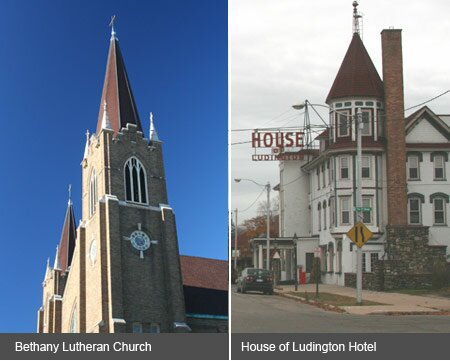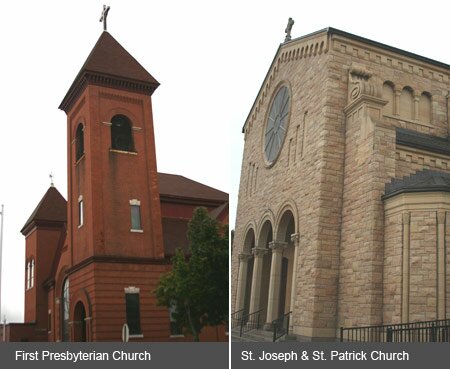

Fur trader Louis A. Roberts and his family were the first to settle in the Escanaba area in 1830. Over the years, the area began to grow with sawmills prospering along the Escanaba River and more families establishing roots. In 1863, the City of Escanaba was organized. It was originally spelled Escanawba, with the 'w' removed years later.
U.P. Steam & Gas Engine Museum is located within the U.P. State Fairgrounds on North Lincoln Road. The museum has steam-powered tractors and other agricultural equipment on display. It is open during the U.P. State Fair (the third week of August) and on Labor Day Weekend.
Sand Point Lighthouse was established in 1867 at a cost of $11,000. The brick lighthouse has a 41-foot-tall tower and a Fresnel lens that flashes its light every four seconds. The lighthouse had been retired in 1939 and used as a Coast Guard residence until 1985. The light was reactivated in 1989 and is currently maintained by the Delta County Historical Society. A Michigan historical marker is located near the entrance for the lighthouse. The lighthouse opens for tours from Memorial Day through Labor Day.
The First United Methodist Church was originally founded in 1869. The English gothic-style church on Second Avenue South was built in 1907, patterned after a church in Leeds, Yorkshire, England. It was built with field stone. The interior of First United Methodist Church has maple floors and feathered oak woodwork. For the worship schedule, visit the First United Methodist Church web site.
Bethany Lutheran Church was originally founded in Escanaba in 1879 on a parcel of land donated by Nelson Ludington. The current building hosted its first worship service in 1912. Bethany Lutheran Church has two tall steeples and is one of the most beautiful churches in Escanaba. For a worship schedule, visit the Bethany Lutheran Church web site.
First Presbyterian Church began with a small gathering in the home of Samuel Hart Seldon in 1864. Seldon was the engineer in charge of Chicago and North Western Railroad's construction. The church moved into its first church in 1866 and continued to grow. The current church was completed in 1899. For the worship schedule, see the First Presbyterian Church web site.
The old Carnegie Library building in Escanaba was built in 1902 with a grant from Andrew Carnegie. The building was listed on the State Register of Historic Places in 1976 and listed on the National Register of Historic Places in 1977. The building, located at First Avenue South and 7th Street, is now a private residence.
Originally the auditorium and gymnasium for St. Joseph Church, the building for the William Bonifas Fine Arts Center dates back to 1938. The fine arts center is named for "Big Bill" Bonifas, who immigrated from Luxembourg to the Upper Peninsula in the 1880s and became a wealthy lumber baron. The William Bonifas Fine Arts Center hosts cultural activities and educational programs.
Hereford & Hops Steakhouse & Brewpub is located on the first floor of building built in 1914, which is at 624 Ludington Street in downtown. For more about the restaurant, visit the Hereford & Hops web site.
Historical Museum
The Delta County Historical Museum is located behind Sand Point Lighthouse, near Ludington Park. The building was originally WDBC Radio, which operated there from 1941 through the 1950s. Delta County Historical Museum features exhibits, heirlooms, artifacts, and historical information. The museum is open from Memorial Day through Labor Day and is maintained by the Delta County Historical Society.U.P. Steam & Gas Engine Museum is located within the U.P. State Fairgrounds on North Lincoln Road. The museum has steam-powered tractors and other agricultural equipment on display. It is open during the U.P. State Fair (the third week of August) and on Labor Day Weekend.
Historic Locations
Built in 1864 by E. Gaynor, the House of Ludington was after lumberman Nelson Ludington. The hotel has been affectionately called the "Great White Castle of the North" because of the exterior's cupolas. During its long history, the hotel has hosted Henry Ford, Johnny Cash, John Sousa, Patricia Neal, Prince Bertil of Sweden, Jimmy Hoffa, Guy Lombardo, Randy Travis, George Gobel, and many others. A Michigan historical marker is located at the front of the hotel on Ludington Street. For more information and reservations, visit the House of Ludington web site.
Sand Point Lighthouse was established in 1867 at a cost of $11,000. The brick lighthouse has a 41-foot-tall tower and a Fresnel lens that flashes its light every four seconds. The lighthouse had been retired in 1939 and used as a Coast Guard residence until 1985. The light was reactivated in 1989 and is currently maintained by the Delta County Historical Society. A Michigan historical marker is located near the entrance for the lighthouse. The lighthouse opens for tours from Memorial Day through Labor Day.
The First United Methodist Church was originally founded in 1869. The English gothic-style church on Second Avenue South was built in 1907, patterned after a church in Leeds, Yorkshire, England. It was built with field stone. The interior of First United Methodist Church has maple floors and feathered oak woodwork. For the worship schedule, visit the First United Methodist Church web site.
Bethany Lutheran Church was originally founded in Escanaba in 1879 on a parcel of land donated by Nelson Ludington. The current building hosted its first worship service in 1912. Bethany Lutheran Church has two tall steeples and is one of the most beautiful churches in Escanaba. For a worship schedule, visit the Bethany Lutheran Church web site.
First Presbyterian Church began with a small gathering in the home of Samuel Hart Seldon in 1864. Seldon was the engineer in charge of Chicago and North Western Railroad's construction. The church moved into its first church in 1866 and continued to grow. The current church was completed in 1899. For the worship schedule, see the First Presbyterian Church web site.

The old Carnegie Library building in Escanaba was built in 1902 with a grant from Andrew Carnegie. The building was listed on the State Register of Historic Places in 1976 and listed on the National Register of Historic Places in 1977. The building, located at First Avenue South and 7th Street, is now a private residence.
Originally the auditorium and gymnasium for St. Joseph Church, the building for the William Bonifas Fine Arts Center dates back to 1938. The fine arts center is named for "Big Bill" Bonifas, who immigrated from Luxembourg to the Upper Peninsula in the 1880s and became a wealthy lumber baron. The William Bonifas Fine Arts Center hosts cultural activities and educational programs.
Hereford & Hops Steakhouse & Brewpub is located on the first floor of building built in 1914, which is at 624 Ludington Street in downtown. For more about the restaurant, visit the Hereford & Hops web site.
Historical Markers
Escanaba has a few Michigan Historical Markers that describe places and people from the town's past. The green markers are in locations that are considered significant by the Michigan Historical Commission.- House of Ludington - The marker is near the entrance to the hotel, which is located at 223 Ludington Street.
- Sand Point Lighthouse - The historical marker is within the fence that surrounds the lighthouse, which is on the north side of Ludington Park.
- Ludington Park - On the northeast side of the park along Ludington Street, there is a historical marker for Little Bay De Noc.
|
|